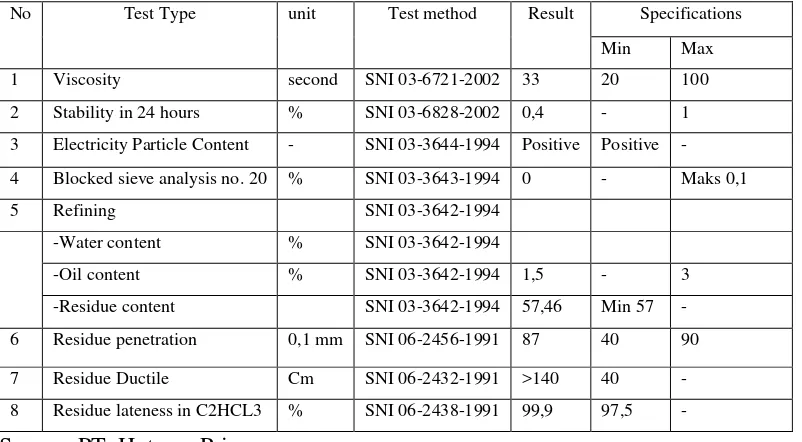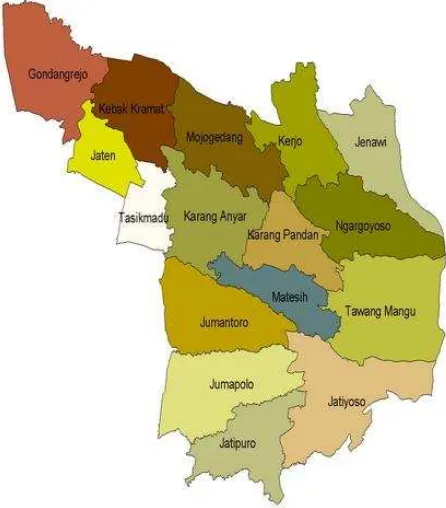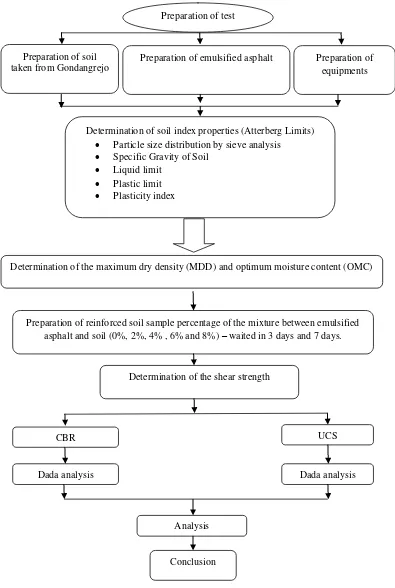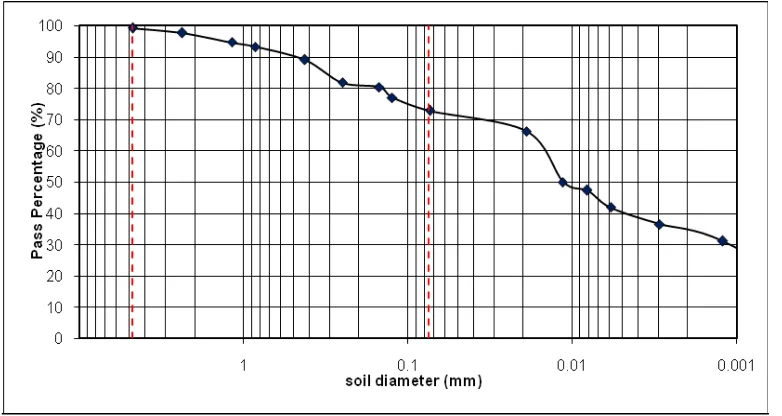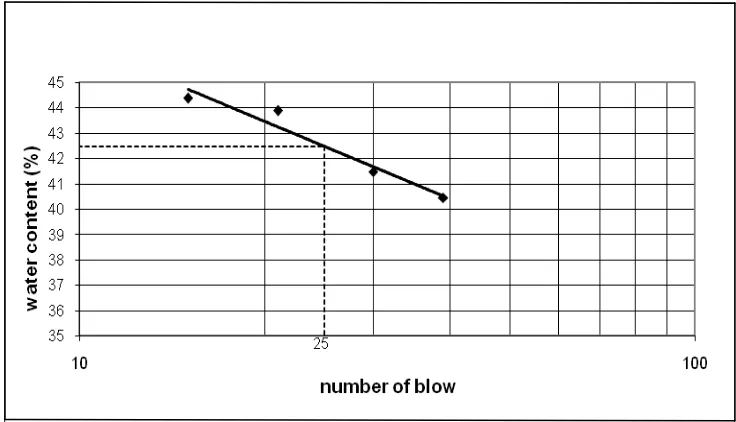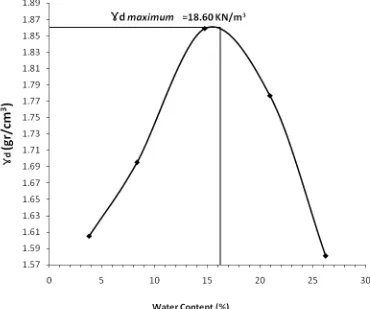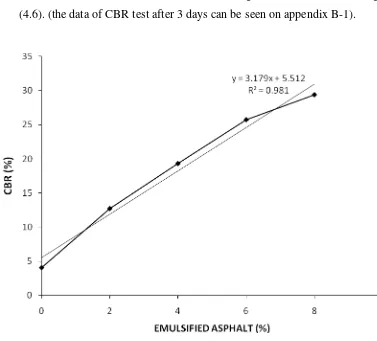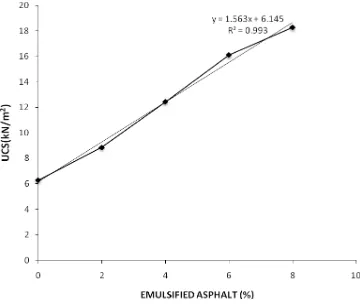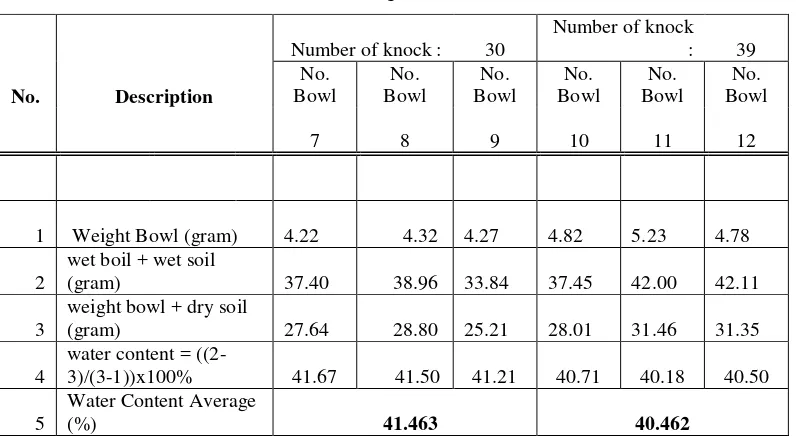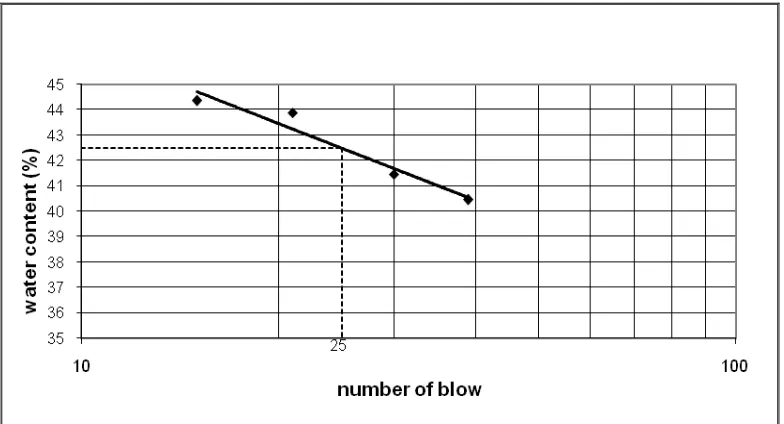T H E S I S
Submitted to the Post Graduate of Civil Engineering Program in Partial Fulfillment of the Requirements for the Degree of Master of Engineering
in Infrastructure
By:
ABD RAUOF YOUNIS MOUSSA KREEM S941 302 030
MASTER OF CIVIL ENGINEERING GRADUATE PROGRAM SEBELAS MARET UNIVERSITY
v
will make research entitled Subgrade Improvement Using Emulsified Asphalt for Pavement Design. The aims of this study to find the physical properties of soil from Gondangrejo Karanganyar and to find the reaction and effect to soil mix emulsified asphalt.
Tests were done at the Civil Engineering Laboratory of Sebelas Maret University. The physical properties of problematic soil of Jalan Mayor Ahmadi Gondangrejo Karanganyar and the effect of soil asphalt mixture on rehabilitation were investigated through the use of emulsified asphalt of 0%, 2%, 4%, 6% and 8%. The physical properties of problematic soil of Jalan Mayor Ahmadi Gondangrejo Karanganyar are clay and mud. Sieve analysis result is gravel (0.68%), sand (26.38%), silt and clay (72.93%). The specific gravity is 2.75. Liquid limit 42.48.plastic limit 25.64. Plasticity index 16.83 %. (OMC) = 16.20 % and ɤd
maximum = 1.860 gr/cm3 = 18.60 KN/cm3. CBR test after 3 days. 0% = 4.07, 2% = 12.17, 4% = 19.29, 6% = 25. 71 and 8% gets 29.36. CBR test after 7 days. 0% = 4.07, 2% = 17.82, 4% = 21.05, 6% = 26.37 and 8% gets 32.64. UCS test after 3 days. 0% = 6.279, 2% = 9.618, 4% = 12.047, 6% =16.293 and 8% gets 17.628. UCS testafter 7 days.0% = 6.279, 2% = 8.859, 4% = 12.449, 6% = 16.128 and 8% gets 18.278. The effect of soil asphalt mixture on rehabilitation can improve subgrade for pavement design. The results are not significant between 3 days and 7 days. The different result gives the point that the important thing is in percentage of emulsified asphalt.
vi
Tanah bermasalah adalah masalah infrastruktur yang terkait dengan tanah terhadap jalan, bangunan, dan beberapa proyek lainnya. Tanah bermasalah pada jalan adalah alasan penelitian ini dilakukan. Penelitian ini diberi judul
“Peningkatan Tanah Dasar Menggunakan Aspal Emulsi untuk Rancangan
Perkerasan”. Tujuan penelitian ini adalah untuk mengetahui sifat-sifat fisik tanah di Gondangrejo Karanganyar dan reaksi dan efek campuran tanah terhadap aspal emulsi.
Pengujian bahan dilakukan Laboratorium Teknik Sipil Universitas Sebelas Maret. Untuk mengetahui sifat-sifat fisik tanah bermasalah pada Jalan Mayor Ahmadi Gondangrejo Karanganyar dan efek campuran aspal tanah pada rehabilitasi, digunakan aspal emulsi 0%, 2%, 4%, 6% dan 8%.
Sifat-sifat fisik tanah bermasalah pada Jalan Mayor Ahmadi Gondangrejo Karanganyar mencakup tanah liat dan lumpur. Hasil analisis saringan menunjukkan bahwa tanah pada jalan tersebut tersusun dari kerikil (0,68%), pasir (26,38%), dan lumpur dan tanah liat (72,93%). Berat jenisnya = 2.75; batas cairnya = 42.48 dan batas plastinya = 25,64. Indeks plastisitas = 16,83%. (OMC) = 16.20% dan ɤd maksimum = 1.860 gr / cm3 = 18,60 KN/ cm3. Nilai tes CBR
setelah 3 hari adalah 0% = 4,07; 2% = 12.17; 4% = 19,29; 6% = 25, 71; dan 8% = 29.36. Nilai tes CBR setelah 7 hari adalah 0% = 4,07; 2% = 17,82; 4% = 21,05; 6% = 26,37; dan 8% = 32,64. Nilai tes UCS setelah 3 hari adalah 0% = 6,279; 2% = 9,618; 4% = 12,047; 6% = 16,293; dan 8% = 17,628. Nilai tes UCS setelah 7 hari adsalah 0% = 6,279; 2% = 8,859; 4% = 12,449; 6% = 16,128; dan 8% = 18,278. Pengaruh campuran aspal tanah pada rehabilitasi dapat meningkatkan tanah dasar untuk rancangan perkerasan. Berdasarkan hasil analsis, dapat disimpulkan bawah terdapat perbedaan nilai hasil, yaitu hasilnya tidak signifikan antara 3 hari dengan 7 hari. Hasil yang berbeda tersebut menitikberatkan bahwa yang penting dalam pencampuran adalah persentase aspal emulsi.
vii
SHEET OF APPROVAL ... iii
ABSTRACT ... iv
TABLE OF CONTENTS ... v
LIST OF FIGURES ... vi
LIST OF TABLES ... vii
LIST OF APPENDIXES ... viii
CHAPTER I:INTRODUCTION ... 1
1.1 Background ... 1
1.2 Research Problem ... 3
1.3 Limitation ... 3
1.4 Research Objective ... 4
1.5 Benefit of Study ... 4
CHAPTER II: LITERATURE REVIEW& BASIC THEORY ... 5
2.1 Literature Review... 5
2.1.1 Stabilization of Soil ... 6
2.1.2 Emulsified Asphalt ... 9
2.2 Basic Theory ... 12
2.2.1 Stabilization of Soil ... 12
2.2.2 Emulsified Asphalt ... 18
viii
3.3.Data Type ... 22
3.4.Data Collection ... 22
3.5.Validation and Clarification ... 23
3.6.Analysis ... 23
3.6.1. Physical Properties... 23
3.6.2. Effect of Mixing Emulsified Asphalt ... 23
3.7. Flow Chart of Research ... 24
CHAPTER IV: RESULT AND DISCUSSION ... 25
4.1.Introduction ... 25
4.2. Material Test ... 25
4.2.1. Soil and Emulsified Asphalt ... 25
4.3.Result and Discussion ... 27
4.3.1. Determination of Soil Index Properties ... 27
4.3.2. Proctor test ... 29
4.3.3. Mixture Design ... 30
4.3.4. California Bearing Ratio Test ... 31
ix
x
Figure2.1.Effect of UCS on (RHA) ... 7
Figure 2.2.Effect of CBR on lime ... 7
Figure 2.3. Effect of (C) on lime ... 7
Figure 2.4. Effect of (φ) on lime ... 7
Figure 2.5.Effect of cement and lime on UCS ... 8
Figure 2.6.Correlation between Cohesion and Emulsified Asphalt ... 9
Figure 2.7.AASHTOO Clasification System ... 15
Figure 3.1 Map of Karanganyar ... 21
Figure 4.1. Picture of soil at Gondangrejo ... 26
Figure 4.2.Emulsified asphalts from PT Hutama Prima ... 26
Figure. 4.3 Test Result of Grain Size Analysis ... 27
Figure 4.4. Charts of Liquid Limit ... 28
Figure 4.5.Relation graph of OMC and MDD ... 30
Figure 4.6.The effect of emulsified asphalt on CBR after 3 days ... 31
Figure 4.7.The effect of emulsified asphalt on CBR after 7 days ... 32
Figure 4.8.The effect of emulsified asphalt on CBR after 3& 7 days ... 34
Figure 4.9.The effect of emulsified asphalt on UCS after 3 days ... 35
Figure 4.10.The effect of emulsified asphalt on UCS after 7 days ... 36
Figure 4.11.The effect of emulsified asphalt on UCS after 3 & 7 days ... 37
xi
Table.2.3. Advantages and disadvantages of emulsified asphalt ... 20
Table 3.1 Research parameter ... 21
Table 3.2 Research variable ... 22
Tabel 4.1.Range of specific gravity for different soil types ... 28
Table 4.2.Physical and Mechanic Characteristics of Original Soil ... 29
Table 4.3.CBR test after 3 days and 7 days ... 33
Table 4.4 UCS test after 3 days and 7 days... 37
xii APPENDIX B = CBR test and UCS test
1
CHAPTER I
INTRODUCTION
1.1. Background
Pavement structure is a combination of sub-base, base course, and surface course placed on a sub-grade to support the traffic load and to distribute it to the roadbed. Soil improvement is important to overcome the problem in Gondangrejo. The location is on Jalan Mayor Ahmadi in Gondangrejo Sub-district, Karanganyar Regency, which is around 20 km from Surakarta City as shown in Figure 1.1.
Figure 1.1 Map of Karanganyar
Some of the problems of soil are expansive soil, dispersive soil and collapsible soil. Rezaei (2011) states that expansive soil is some soils which undergo a low volume change. When the water content changes, independent loading occurs, and these are attributable to swelling or shrinkage. He adds that dispersive soil is dispersion occurring in soils when the repulsive forces between clay particles exceed the attractive forces, thus bringing about deflocculating, so that in the presence of relatively pure water the particles repel each other to form colloidal suspensions. Collapsible soils are moisture-sensitive in which increase in moisture content is the primary triggering mechanism for the volume reduction of these soil.The condition of the road in Gondangrejo is bad as shown in Figure 1.2, meaning that the sub-grade is weak and it is one of problematic soil and needs treatment.
Figure.1.2. Location of Road in Gondangrejo, Karanganyar
The physical properties of problematic soil of Gondangrejo become the focus in laboratory examination in this research. This study examines the characteristics of soil and repairs the problems. The research use emulsified asphalt to make a treatment for problems in the soil. From another research, emulsified asphalt is used in soil stabilization because the nature of asphalt stabilization is so mechanistic. The researcher examines the effect of soil asphalt mixture on rehabilitation. The result can be as guidance for construction project of road, and it can be useful for civil engineering. For government, it can be as a guidance to make a plan for making a good road.
Based on the above explanations, this research uses emulsified asphalt to add stabilization. Based on those considerations, the researcher entitles the research as Sub-grade Improvement Using Emulsified Asphalt for Pavement Design.
1.2. Research Problem
The problems of research are formulated as follows:
a. What are the physical properties of problematic soil of Solo-Gondangrejo Karanganyar road especially in Jalan Mayor Ahmadi ?
b. What is the effect of soil asphalt mixture on rehabilitation?
1.3. Limitation
The scope of this study is emulsified asphalts to treat the problematic soil for the road. The study does not use cost aspects. It is not done in the field but in a laboratory.
a. Soil sample is taken from Gondangrejo in Karanganyar.
1.4. Research Objective
The objective of this study is to treat problematic soil by using emulsified asphalts so as to investigate:
a. physical properties of soil from Gondangrejo Karanganyar; and b. reaction and effect of soil mix on emulsified asphalt.
1.5. The Benefit of Study 1.5.1. Theoretical Benefit
Theoretically, the result of this research is expected to give contribution to knowledge and research program in civil pavement design.
1.5.2. Practical Benefit
5
CHAPTER II
LITERATURE REVIEW
2.1. Literature Review
Soils are generally stabilized not only to increase their strength and durability, but also to prevent erosion and dust formation in soils (Sen and Kasyhap, 2012). The main aim is to create the soil material or system that will hold underuse conditions and for the designed life of the engineering project. The properties of soil vary a great deal at different places or in certain cases even at one place. The success of soil improvement depends on soil testing. Various methods are used for improving the soil, and the method should be verified in the lab with the soil material before applying it in the field. Principles of soil improvement are first, evaluating the soil properties, and then second, deciding the property of soil which needs to be altered to get the designed value and to choose the effective and economical method for stabilization. Soil is all materials including clay, silt, sand, gravel, and boulder, namely big stones. Soil found in the nature generally consists of several kinds of sizes/characteristics, for instance, gravels mixed up with sand, sandy loam, etc.
2.1.1. Stabilization of Soil
The study by Al-Khashab and Al-Hayalee’ (2008) deals with the possibility of the stabilization of expansive clayey soil pre-treated by lime, with an emulsified asphalt addition. Soil from the "2nd Kafaat" District in Mosul was chosen. It is classified as medium to high expansiveness. Their research focus in the pre-treated soil was performed with lime addition (0.5, 1.0, and 1.5%) by weight. After short period, emulsified asphalt was added with different percentages namely (2, 4, 6 and 8) by weight, for optimum percentages of an emulsified asphalt to give the most useful stabilization aspects. The test result of lime addition alone shows that there was a considerable reduction in soil plasticity, 1.5% of lime addition converted the clayey soil towards non-plastic types. The emulsified asphalt addition to the mixture caused slight increase in the plasticity but, their values in the whole remained below the value of the natural soil.
Sabat's (2014) research focuses on engineering properties of an expansive soil stabilized with Rice Husk Ash (RHA) and lime sludge. Compaction properties, California bearing ratio, shear strength parameters, compression index, swelling pressure and durability of an expansive soil stabilized with rice husk ash and lime sludge have been discussed in this paper. RHA added to soil was from 5 to 20% in steps of 5% and lime sludge from 4 to 16% in steps of 4%. Properties of the stabilized soil studied were, (UCS) as shown in Figure 2.1., (CBR) of soil as shown in Figure 2.2., cohesion as shown in Figure 2.3., and angle of internal friction as shown in Figure 2.4. The optimum percentage of RHA and lime sludge for stabilization of soil was found to be 10% and 16% respectively.
Figure2.1.Effect of UCS on (RHA)% Figure 2.2.Effect of CBR on lime %
Source : Sabat (2014) Source : Sabat (2014)
Riaz . S, et al (2014) in their study focus on stabilization of sub-grade soils using cement and lime. The purpose of the study was to stabilize sub-soil using soil improvement techniques to reduce the cost of construction. For this purpose, disturbed samples from Kala Shah Kaku (KSK) were tested to evaluate the effect of different additives on strength of soil. Further two different additives i.e. Lime and Ordinary Portland cement (OPC) were chosen for treatment of soil obtained from KSK area. Samples were remolded by addition of additives in varying percentages up to 2-8% cement and 4-15% lime by dry weight of the soil. From the study, it is concluded that the application of cement & lime showed tremendous improvement in UCS and CBR value with increase in cement or lime contents as shown in Figure 2.5.
Figure 2.5.Effect of cement (a) and lime (b) on unconfined compressive strength (qu) at various percentages of cement with time.
2.1.2 Emulsified Asphalt
Bunga's (2011) study deals with stabilization of sandy clay loam with emulsified asphalt. His study was to solve easily eroded sandy clay loam problem. The study was conducted by using emulsified asphalt as stabilization material. The soil samples were obtained from Manuju village, Gowa regency, South Sulawesi province (E.1190 41.035,, S.050 17.509,,+ 269 m). Emulsified asphalt type CSS-1S was obtained from PT. Widya Sapta Colas. The emulsified asphalt concentrations were 1.5%, 3.0%, and 4.5%. The results of the study indicate that stabilization material for emulsified asphalt could improve physical, chemical, and mechanic characteristics of sandy clay loam. Chemical bindings occurred among the soil minerals and emulsified asphalt. Plasticity and shear strength of soil increased in line with the increase of emulsified asphalt concentration as shown in
Figure 2.6.
Bunga's (2012) study aims at investigating the stabilization effect of emulsified asphalt on erosion rate of sandy clay loam. The soil sample was obtained from the Jeneberang watershed area that is at Manuju village, Gowa
regency, South Sulawesi province (E.1190 41.035’, S. 050 17.509’, + 269 m).
Emulsified asphalt type CSS-IS was obtained from PT Wydya Sapta Colas. The test was done by rain simulation using Rainfall Simulator. The research parameters comprised rainfall intensity (50 mm/hour; 65 mm/hour; 80 mm/hour), degree of slope (100; 200; 300), and emulsified asphalt volume (0 cc/m2; 60 cc/m2; 80 cc/m2; 100 cc/m2) with length of storage 3 days. The data were analyzed by using the descriptive quantitative method from regression analysis results and correlation of erosion rate parameter with rain intensity parameter, slope, and emulsified asphalt volume. The results of the study indicate that erosion rate increased exponentially in line with the increase of rainfall intensity and linearly by the increase of slope, but it decreased exponentially by the increase of emulsified asphalt volume. The stabilization of sandy clay loam with emulsified asphalt could reduce the erosion rates of 61.58%, 72.42%, and 86.14% respectively at the stabilizations of emulsified asphalt of 60 cc/m2, 80cc/m2, and 100 cc/m2 respectively.
There are some difference between the researcher and other researches taken from previous studies as shown in Table.2.1.
Table.2.1. Comparison of this research with previous researches N
o
Author and Title
Description of other researches
Description of This research
1. AlKhasha , et al 2008. Stabilization of expansive clayey soil modified by lime with an emulsified asphalt addition.
Using lime, with an emulsified asphalt
2. Bunga, Elifas. 2011. Stabilization
of Sandy
Clay Loam
With Emulsified Asphalt.
Stabilization of sandy
clay loam with
emulsified asphalt Using emulsified
asphalt type CSS-1S Soil (sand clay loam)
Emulsified asphalt concentrations (1.5%, 3.0% and 4.5%). Tests were done by
direction shear tests
Sub-grade improvement
using emulsified asphalt for pavement design
Using emulsified asphalt type CSS-1H
Soil (clay mud)
Emulsified asphalt
concentrations (0%, 2%, 4%, 6% and 8%).
Tests were done by CBR and UCS tests
3. Bunga, Elifas. 2012. Stabilization
Effect of
Emulsified Asphalt On Erosion Rate
of Sandy
Clay Loam
Stabilization effect of emulsified asphalt on erosion rate
Using emulsified asphalt type CSS-IS Soil (sand clay loam) Emulsified asphalt
volume were (0
cc/m2; 60 cc/m2; 80 cc/m2; 100 cc/m2) The test was done by
using Rainfall
Simulator.
Length of storage of the samples was 3 days.
Sub-grade improvement
using emulsified asphalt for pavement design
Using emulsified asphalt type CSS-1H
Soil (clay mud)
Emulsified asphalt
concentrations were 0%, 2%, 4%, 6% and 8%
The tests were done by UCS test and CBR test The lengths of storage of the
samples were 3 days and 7 days.
2.2. Basic Theory
2.2.1 Stabilization of Soil
The purpose of sub-grade stabilization is to enhance the strength of the sub-grade. This increased strength is then taken into account in the pavement design process. Stabilization requires more thorough design methodology during construction than modification. The methods of sub-grade modification or stabilization include physical processes such as soil densification, blends with granular material, use of reinforcements, undercutting and replacement, and chemical processes such as mixing with cement, fly ash, lime, lime by products, and blends of any one of these materials. Soil properties such as strength, compressibility, hydraulic conductivity, workability, swelling potential, and volume change tendencies may be altered by various soil modification or stabilization methods. Sub-grade modification shall be considered for all the reconstruction and new alignment projects. When used, modification or stabilization shall be required for the full roadbed width including shoulders or curbs. Some steps for soil analyzing in soil stabilization research are as follows: 1. Determination of soil index properties (Atterberg Limits)
a. Particle size distribution by sieve analysis
b. Specific gravity of the soil
The specific gravity of soil is the ratio between the weight of the soil solids and weight of equal volume of water. It is measured by the help of a volumetric flask in a very simple experimental setup where the volume of the soil is found out and its weight is divided by the weight of equal volume of water.
Gs (2.1)
Where
W1=Empty weight of pycnometer
W2=Weight of pycnometer + oven dry soil
W3=Weight of pycnometer + oven dry soil + water W4=Weight of pycnometer + water full
c. Liquid limit
The Casagrande tool cuts a groove of size 2mm wide at the bottom and 11 mm wide at the top and 8 mm high. The number of blows used for the two soil samples to come in contact is noted down. Graph is plotted taking number of blows on a logarithmic scale on the abscissa and water content on the ordinate. Liquid limit corresponds to 25 blows from the graph.
d. Plastic limit
e. Plasticity index
The plasticity index (PI) is a measure of the plasticity of a soil. The plasticity index is the size of the range of water contents where the soil exhibits plastic properties. The PI is the difference between the liquid limit and the plastic limit. Plasticity index (PI) was also calculated with the help of liquid limit and plastic limit;
PI = LL – PL (2.2) Where:
PI= Plasticity Index LL= Liquid limit PL= Plastic limit
Figure 2.7. AASHTOO Classification System Source : Dallas and Nair (2009)
2. Determination of the maximum dry density (MDD) and the corresponding optimum moisture content (OMC) of the soil by Proctor compaction test.
(2.3)
(2.4)
(2.5)
3. Determination of the shear strength by:
a. California Bearing Ratio (CBR).
The California bearing ratio (CBR) is a penetration test for evaluation of the mechanical strength of road sub grades and base courses. It is developed by the California Department of Transportation. The test is performed by measuring the pressure required to penetrate a soil sample with a plunger of standard area. The measured pressure is then divided by the pressure required to achieve an equal penetration on a standard crushed rock material.
The CBR rating is developed for measuring the load-bearing capacity of soils used for building roads. The CBR can also be used for measuring the load-bearing capacity of unimproved airstrips or for soils under paved airstrips. The harder surface, the higher CBR rating is. A CBR of 3 equates to tilled farmland, a CBR of 4.75 equates to turf or moist clay, while moist sand may have a CBR of 10. High quality crushed rock has a CBR over 80. The standard material for this test is crushed California limestone which has a value of 100.
Where =
p = measured pressure for site soils [N/mm²]
ps = pressure to achieve equal penetration on standard soil [N/mm²]
b. Unconfined compression Strength test (UCS).
The primary purpose of the Unconfined Compression Strength test is to quickly determine a measure of the unconfined compressive strength of rocks or fine-grained soils that possess sufficient cohesion to permit testing in the unconfined state. This measure is then used to calculate the unconsolidated undrained shear strength of the clay under unconfined conditions. In general, The UCS can be conducted on rock samples or on undisturbed, reconstituted or compacted cohesive soil sample. The unconfined compression test, the sample is placed in the loading machine between the lower and upper plates. Before starting the loading, the upper plate is adjusted to be in contact with the sample and the deformation is set as zero. The test then starts by applying a constant axial strain of about 0.5 to 2% per minute. The load and deformation values are recorded as needed for obtaining a reasonably complete load-deformation curve. The loading is continued until the load values decrease or remain constant with increasing strain, or until reaching 20% (sometimes 15%) axial strain. At this state, the samples are considered to be at failure. The samples are then removed for measurement of the water content.
ϥ
u = (P/2A)(2.7)
Where:
ϥ
u = The unconfined compressive strength in kPaP = Maximum load in kN.
2.2.2 Emulsified Asphalts
Dallas and Nair (2009) state that emulsified asphalts are used in soil stabilization because the nature of asphalt stabilization is so mechanistically different from chemical stabilization. The mechanism of stabilization for non-traditional stabilizers varies greatly among the stabilizers. Asphalt may or may not be grouped as a traditional stabilizer depending on perspective. Asphalt is not a
“chemical” stabilizer in the sense that it does not react chemically with the soil to
produce a product that alters surface chemistry of the soil particles or that binds particles together.
Emulsified asphalt is an intimate mixture of water, asphalt and emulsifying agent. It has an advantage over hot asphalt in that it can be used with cold or hot aggregates under their dry, damp or wet conditions. Its use with wet aggregates is an advantage for this material over other types of liquid asphalt (i.e. Cutback). In addition, emulsified asphalt does not need any heat for its application (Hopson and Pohl in Al-Kashab and Al-Hayalee, 2008).
Based on the electrical charge that it contains, asphalt emulsion can be distinguished as:
1. Cationic, also called acid emulsion asphalt, an asphalt emulsion positively charged electric current.
2. Anionic, also called alkaline asphalt emulsion, bitumen emulsion is charged negative.
3. Nonionic, an asphalt emulsion that does not ionize, meaning that it does not conduct electricity.
An asphalt emulsion which does not ionize means that it does not conduct electricity. In addition to grouping according to what is mentioned above asphalt can also be divided according to the asphalt emulsion viscosity. The geological distribution of emulsified asphalt is related to the levels of bituminous or its contents due to water content and water content affect the viscosity.
- (MS) Medium setting
- (SS) Slow Setting, type of asphalt emulsion slowest to evaporate.
[image:31.595.114.515.439.660.2]Table (2.2) shows the detail of the results of parameters test of emulsified asphalt of which the values obtained are in the value range required by specification from PT Hutama Prima. This indicates that emulsified asphalt sample studied is suitable to be used in soil stabilization process. Viscosity is due to the friction between neighboring particles in a fluid that are moving at different velocities. Test result uses Indonesian Standard (Standar Nasional Indonesia). Test type of refining consists of water content, oil content and residue content. Test result also uses test type of residue penetration, test type of residue ductile, test type of residue lateness in C2HCL3. All the test results of emulsified asphalt are shown in Table (2.2).
Table.2.2. Test Results of Emulsified Asphalt Characteristic
No Test Type unit Test method Result Specifications
Min Max
1 Viscosity second SNI 03-6721-2002 33 20 100
2 Stability in 24 hours % SNI 03-6828-2002 0,4 - 1
3 Electricity Particle Content - SNI 03-3644-1994 Positive Positive -
4 Blocked sieve analysis no. 20 % SNI 03-3643-1994 0 - Maks 0,1
5 Refining SNI 03-3642-1994
-Water content % SNI 03-3642-1994
-Oil content % SNI 03-3642-1994 1,5 - 3
-Residue content SNI 03-3642-1994 57,46 Min 57 -
6 Residue penetration 0,1 mm SNI 06-2456-1991 87 40 90
7 Residue Ductile Cm SNI 06-2432-1991 >140 40 -
8 Residue lateness in C2HCL3 % SNI 06-2438-1991 99,9 97,5 -
Emulsified asphalt has advantages and disadvantages as shown in Table.2.2. Table.2.3. Advantages and disadvantages of emulsified asphalt
Advantages
Disadvantages
Highly adhesive
The emulsified asphalt addition to the mixture, causing slight
increase in the plasticity Can be used with cold or hot
aggregates
Can be used with damp or wet conditions.
Emulsified asphalt does not need any heat for its application
Excellent penetration into miniature pores of sub bases
Easy spray
Low temperature cure
Bind loose aggregates together strongly
Emulsified asphalt is so mechanistically with soil stabilization
2.3. Hypothesis
21
CHAPTER III
RESEARCH METHODOLOGY
3.1. Location
[image:33.595.211.434.279.533.2]The location of research was on Jalan Mayor Ahmadi in Gondangrejo Sub-district, Karanganyar regency, which is around 20 km from Surakarta City as shown in figure 3.1.
Figure 3.1 Map of Karanganyar
Location of research in Gondangrejo, Karanganyar Regency
3.2. Parameter and Variable
Parameter and variable in this research are presented in Tables 3.1 and 3.2. Table 3.1 Research parameter
Parameter Analysis
Soil Determination of soil index properties
Table 3.2 Research variable
Variable Analysis
Mix soil & Emulsified Asphalt
-California Bearing Ratio (CBR) -Unconfined Compression Test
3.3. Data Type
The research used the quantitative research, which is an excellent way of finalizing results and proving or disproving a hypothesis as the structure has not changed for centuries and its standard is across many scientific fields and disciplines.
3.4. Data Collection
The experimental work consisted of the following steps: 1. Determination of soil index properties (Atterberg Limits)
a. Particle size distribution by sieve analysis b. Specific gravity of soil
c. Liquid limit by Casagrande’s apparatus d. Plastic limit
e. Plasticity index
2. Determination of the maximum dry density (MDD) and the corresponding optimum moisture content (OMC) of the soil by proctor compaction test. 3. Preparation of reinforced sub-grade samples (using emulsified asphalt) 4. Determination of the shear strength by:
a. California Bearing Ratio (CBR).
3.5. Validation and Clarification
The soil was examined in the laboratory to get real of valid data. In previous study, Bunga's (2011) used the maximum contents of emulsified asphalt until 4.5%. Due to the limited the time, in this research the researcher mixed the soil and the emulsified asphalt with the contents of emulsified asphalt of 0%, 2%, 4%, 6% and 8%.
The materials for research were:
1. Soil: taken from Gondangrejo, Karanganyar Regency. 2. Reinforcement: Emulsified Asphalt.
3.6. Analysis
The experimental work consisted of some analyses with the following steps:
3.6.1 Physical Properties
1. Determination of soil index properties (Atterberg Limits) a. Particle size distribution by sieve analysis.
b. Specific gravity of soil.
c. Liquid limit by Casagrande’s apparatus. d. Plastic limit.
e. Plasticity index.
2. Determination of the maximum dry density (MDD) and the corresponding optimum moisture content (OMC) of the soil by Standard Proctor Compaction test.
3.6.2 The Effect of Mixing Emulsified Asphalt
1. Preparation of reinforced sub-grade samples (using emulsified asphalt). 2. Determination of the shear strength by:
a. California Bearing Ratio (CBR).
3.7 Flow Chart of Research
Figure 3.2 Flow-Chart of Research Process Preparation of test
Preparation of soil taken from Gondangrejo
Determination of soil index properties (Atterberg Limits) Particle size distribution by sieve analysis
Specific Gravity of Soil Liquid limit
Plastic limit Plasticity index
Preparation of emulsified asphalt Preparation of equipments
Determination of the maximum dry density (MDD) and optimum moisture content (OMC)
Preparation of reinforced soil sample percentage of the mixture between emulsified asphalt and soil (0%, 2%, 4% , 6% and 8%) – waited in 3 days and 7 days.
Determination of the shear strength
UCS CBR
Dada analysis Dada analysis
Analysis
25
CHAPTER IV
RESULT AND DISCUSSION
4.1 Introduction
The physical properties of problematic soil of Gondangrejo were investigated in laboratory. The study examined the characteristic of soil and solves the problems. Emulsified asphalt was as a treatment agent for problems in the soil.. It was carried out at Soil Mechanic Laboratory, Civil Engineering Department, Sebelas Maret University. In this study, the proposed hypothesis was that emulsified asphalt can improve the subgrade for pavement design. In addition, the research also investigated the effect of soil asphalt mixture on rehabilitation. This section describes the data obtained through some steps.
4.2 Materials Test
4.2.1. Soil and Emulsified Asphalt a. Soil
Figure 4.1. Picture of soil in Gondangrejo
b. Emulsified Asphalt
Emulsified asphalts are used in soil stabilization because the nature of asphalt stabilization is so mechanistically different from chemical stabilization. The detailed results of seven-parameter test of emulsified asphalt of which the values obtained are in the value range required by specification from PT Hutama Prima. The kind of emulsified asphalt is CSS-1H.
4.3 Result and discussion
4.3.1 Determination of soil index properties
a. Sieve Analysis
[image:39.595.115.506.342.550.2]Sieve analysis (gradation test) is the determination of the proportions of particles within certain size ranges in a granular material by separation on sieves of different size openings. Sieve analysis shows that the soil consists of gravel (0.68%), sand (26.38%), and silt and clay (72.93%) as shown in Figure. 4.3. (the data of save analysis test can be seen on appendix A-1).
Figure. 4.3 Test Result of Grain Size Analysis
b. Specific Gravity
Table 4.1.Range of specific gravity for different soil types (from Sen and Kasyhap, 2012).
SAND 2.63 – 2.67
SILT SAND 2.67 – 2.70
SILTS 2.65 – 2.70
CLAY AND SILTY CLAY 2.67 – 2.80
CLAY 2.70 – 2.80
ORGANIC SOIL 1 + < 2.0
c. Liquid Limit
Test result of liquid limit is42.48 % (the data of liquid limit test can be seen on appendix A-3).
Figure 4.4. Charts of Liquid Limit
d. Plastic Limit Test
Test result of plastic limit is 25.64%.
e. Plasticity index
Table 4.2 Results of Physical and Mechanic Characteristics of Original Soil
No Name of test Result
1 Sieve Analysis Gravel (0.68%), Sand (26.38%), Silt and Clay (72.93%).
2 Specificgravity 2.75
3 Liquid Limit 42.48 %
4 Plastic Limit 25.64 %
5 Plasticity index 16.83 %
The objective of the Atterberg limit test is to obtain basic index information about the soil used to estimate strength and settlement characteristics. It is the primary form of classification for cohesive soils. Fine-grained soil is tested to determine the liquid and plastic limits, at which moisture contents define boundaries between material consistency states. These standardized tests produce comparable numbers used for soil identification, classification and correlation to strength. The result is liquid limit (42.48%), Plastic limit (25.64%) and Plasticity index (16.83%). Based on AASHTO classification system this soil belongs to group A-7-6 (clay mud). The AASHTO system uses both grain-size distribution and Atterberg limit data to assign a group classification and a group index to the soil. The group classification ranges from A-1 (best soils) to A-8 (worst soils). Group index values near 0 indicate good soils, while the values of 20 or more indicate very poor soils. However, a soil that may be "good" for use as a highway subgrade might be "very poor" for other purposes, and vice versa.
4.3.2 Proctor test
The Proctor test is a test that is used in geotechnical engineering to investigate the maximum density and optimum moisture content that can be practically achieved for a soil or similar substance. To find MDD and OMC, the
maximum = 1.860 gr/cm3 = 18.60 KN/m3 as shown in Figure 4.5. (the data of Proctor test can be seen on appendix A-6, A-7).
Figure 4.5.Relation graph of MDD and OMC
4.3.3. Mixture Design Test
4.3.4. California Bearing Ratio Test (CBR)
The California Bearing Ratio Test (CBR Test) is a penetration test developed by California State Highway Department (U.S.A.) for evaluating the bearing capacity of sub-grade soil for design of flexible pavement.There are two types of CBR test, soaked and un-soaked. Due to a great deal of samples and a limed time, the researcher used only un-soaked CBR tests in this research.
[image:43.595.116.493.319.660.2]1. The effect of Emulsified Asphalt stabilization on CBR test after 3 days, using concentration content: 2 %, 4%, 6%, 8%. The result of 0% is 4.07. Then 2 % is 12.17, 4 % is 19.29, 6 % is 25. 71 and 8% gets 29.36. as shown in Figure (4.6). (the data of CBR test after 3 days can be seen on appendix B-1).
2. The effect of Emulsified Asphalt stabilization on CBR test after 7 days, using concentration: 2 %, 4%, 6%, 8%. The result of 0% gets 4.07, 2 % gets 17.82, 4 % gets 21.05, 6 % gets 26.37, and 8% gets 32.64. as shown in the Figure 4.7. (the data of CBR test after 7 days can be seen on appendix B-2).
Figure 4.7.The effect of emulsified asphalt on CBR after 7 days
CBR test was held in Soil Mechanic Laboratory, Civil Engineering, Sebelas Maret University.
In seven days the value of CBR stabilized with concentration of emulsified asphalt 2% increases to 17.82 toward the value of CBR without stabilization. Likewise in the stabilization with concentrations of 4%, 6% and 8% the CBR value increases to 21.05, 26.37 and 32.64 respectively toward the value of CBR without stabilization. The best composition in seven days is the concentration of 8% with the result of 32.64.
CBR result gives description about test after three days and seven days. From the test there is a different result, it is not significant from 3 days to 7 days of test as shown in Table 4.3 and Figure 4.8.
Table.4.3. CBR test after 3 days and 7 days
3 DAYS 7 DAYS
0% 4.07 0% 4.07
2% 12.71 2% 17.82
4% 19.29 4% 21.05
6% 25.71 6% 26.37
4.3.5. Unconfined Compressive Strength (UCS)
The Unconfined Compression strength test is a laboratory test method that is used to assess the mechanical properties of rocks and fine-grained soils.
1. The effect of Emulsified Asphalt stabilization on UCS test after 3 days, using the concentration of 2 %, 4%, 6%, 8%. The result of 0% gets 6.279, 2% gets 9.618, 4% gets 12.047, 6% gets16.293, and 8% gets 17.628 as shown in Figure 4.8. (the data of UCS test after 3 days can be seen on appendix B-4).
2. The effect of Emulsified Asphalt stabilization on UCS test after 7 days, using the concentrations of 2 %, 4%, 6%, 8%. The result of 0% gets 6.279, 2% gets 8.859, 4% gets12.449, 6% gets16.128, and 8% gets 18.278 as shown in Figure (4.9). (the data of UCS test after 7 days can be seen on appendix B-5).
Figure 4.10.The effect of emulsified asphalt on UCS after 7 days
UCS test was held in Soil Mechanic Laboratory, Civil Engineering Department, Sebelas Maret University. Unconfined compression test gives shear strength of soil. Shear strength is important in all types of geotechnical designs and analyses.
[image:48.595.128.488.222.530.2]increases to 12.047, 16.293 and 17.628. The best composition in three days is the concentration of 8% with the result of 17.628.
In seven days the value of UCS with the concentration of emulsified asphalt of 2% increases to 8.859. In the other concentrations of 4%, 6% and 8% the value of UCS increases to 12.449, 16.128 and 18.278. The best composition in three days is the concentration of 8% with the result 18.278.
UCS result gives description about test after three days and seven days. From the test there is a different result, and it is not significant from 3 days and 7 days of test as shown in Table 4.4 and Figure 4.11.
Table 4.4 UCS test after 3 days and 7 days
3 DAYS 7 DAYS
0% 6.279 0% 6.279
2% 9.618 2% 8.859
4% 12.047 4% 12.449
6% 16.293 6% 16.128
Figure 4.11The effect of emulsified asphalt on UCS after 3 days and 7 days
After testing CBR and UCS this research gives description about how the emulsified asphalt can give the solution for the problem of subgrade. The result of research shows that emulsified asphalt can improve subgrade for pavement design. The result is taken from after 3 days and seven days from first made. The result between 3 days and seven days has a little different result. In this research, the time of making does not give many influences to the object. The different result gives indicates that the important thing is in the percentage of emulsified asphalt. Shear strength of soil increase in line with the increase of emulsified asphalt.
4.3.6. Comparison of shear strength with Other Research
this research. The comparison shows that the shear strength of soil increases in line with the increase of emulsified asphalt as shown in Table 4.5 and Figure 4.12.
Table 4.5. The comparison of shear strength results with other research Emulsified asphalt %
(Bunga's 2011)
Cohesion (N/cm2)
Emulsified asphalt % (This research)
UCS (KN/m2)
0 % 4.286 0% 6.279
1.5% 6.531 2% 9.618
3.0% 8.934 4% 12.047
4.5% 12.121 6% 16.293
8% 17.628
40
CHAPTER V
CONCLUSION AND SUGGESTION
5.1 Conclusion
From the results of test, analysis of data, and discussion of research some conclusions are drawn as follows:
c. The physical properties of problematic soil of Jalan Mayor Ahmadi Gondangrejo Karanganyar include clay and mud. The result of sieve analysis shows that gravel is 0.68%, sand is 26.38%, silt and clay are 72.93%, specific gravity is 2.75, liquid limit is 42.48%, plastic limit is 25.64%, and plasticity
index is 16.83 %. From the proctor test, w optimum is equal to 16.20 % and
ɤ
dmaximum is 1.860 gr/cm3 = 18.60 KN/m3. Based on AASHTO classification system this soil belongs to group A-7-6 (clay mud).
d. The effect of soil asphalt mixture on rehabilitation can improve subgrade for pavement design. Based on the CBR test after 3 days, 0% gets 4.07, 2 % gets 12.17, 4 % gets 19.29, 6 % gets 25. 71, and 8% gets 29.36. Based on the CBR test after 7 days, 0% gets 4.07, 2 % gets 17.82,4 % gets 21.05, 6 % gets 26.37, and 8% gets 32.64. The result of CBR r gives description about test after three days and seven days. From the test there is a different result. The result is not significant from 3 days and 7 days.
5.2 Suggestion
To follow up this study, some corrections are required so that further research can be better. Therefore, some suggestions are proposed:
1. Other asphalt types that result in better properties for future use should be used.
2. The percentage of emulsified asphalt use should be more than 8%, as to know
REFERENCE
Al-Khashab, Mohammad Nather and Mohammed Thafer Al-Hayalee. 2008. Stabilization of Expansive Clayey Soil Modified by Lime with an Emulsified Asphalt Addition. Eng & Technology. Vol 26.No.10.2008. Bunga, Elifas. 2011. Stabilization of Sandy Clay Loam With Emulsified Asphalt.
International Journal of Civil & Environmental Engineering IJCEE-IJENS Vol:11 No: 05
Bunga, Elifas. 2012. Stabilization Effect of Emulsified Asphalt On Erosion Rate of Sandy Clay Loam. International Journal of Civil & Environmental Engineering IJCEE-IJENS Vol:12 No:02
Dallas N. Little and SyamNair.2009. Recommended Practice for Stabilization of Subgrade Soils and Base Materials. Texas: Texas Transportation Institute Texas A&M University College Station. National Cooperative Highway
Research Program.Contractor’s Final Task Report for NCHRP Project 20 -07.Texas Transportation Institute Texas A&M University College Station :Texas
Rezaei, Mohsen. 2011. Geotechnical Properties of Problematic Soils Emphasis on Collapsible Cases. International Journal of Geosciences. 105-110, March 2012. Published Online February 2012 (http://www.SciRP.org/journal/ijg) Page 105.
Riaz , S, N. Aadil* and U. Waseem. 2014. stabilization of subgrade soils using cement and lime: a case study of kala shah kaku, lahore, pakistan, Pakistan Journal of Science (Vol. 66 No. 1 March, 2014)
Sabat (2014). Engineering Properties of An Expansive Soil Stabilized With Rice Husk Ash (RHA) And Lime Sludge. International Journal of Engineering and Technology ( Vol 5 No 6 Dec 2013-Jan 2014)
Schaefer, V and L Stevens. 2008. Design Guide for Improved Quality of Roadway Subgrades and Subbases. Center for Transportation Research and
Education Iowa State University.
Sen, Arpan and Rishabh Kashyap. 2012. Soil Stabilzation Using Waste Fiber Materials.Rourkela: Department of Civil Engineering National Institute of Technology Rourkela.
SIEVE ANALYSIS
Figure A.1 Sieve Analysis curve
GRAVEL = 0.68 % SAND = 26.38 % SILT & CLAY = 72.93 %
Table A.1 Sieve Analysis
sieve diameter weight blocked weight % weight Percentage
No. W1 pass blocked Pass
(mm) (gr) (gr) W1/W x 100% %
4 4.75 0.41 17.2 0.68 99.32
8 2.360 0.90 16.27 1.50 97.82
16 1.180 1.83 14.44 3.05 94.77
20 0.850 0.84 13.60 1.40 93.37
40 0.425 2.49 11.11 4.15 89.22
80 0.250 4.40 6.71 7.33 81.88
100 0.150 0.91 5.80 1.52 80.37
120 0.125 1.95 3.85 3.25 77.12
200 0.074 2.51 1.34 4.18 72.93
pan 1.34
SPECIFIC GRAVITY
Table A.2 Specific Gravity
Detail
Unit
Pycnometer number
1
2
3
Date Examination
Picnometer weight
(a)
Gram
26.18
26.57
27.68
piknometer weight+
saturated aquades (b)
Gram
75.88
76.55
77.60
piknometer weight +
dry sample ( c )
Gram
36.25
36.60
37.72
piknometer weight +
sampel + aquades (d)
Gram
82.29
82.93
84.02
t1 = temperature (b)
….°
29
29
29
t2 = temperature (d)
….°
30
30
30
T1 = correction
factor at temperature
t1
1.004000
1.004000
1.004000
T2 = correction
factor at temperature
t2
1.004000
1.004000
1.004000
Gs = (c-a)/((b-a)T1 -
LIQUID LIMIT
Table A.3 liquid limit test
number of knock 15 number of knock 21
No. description
No. Bowl No. Bowl No. Bowl No. Bowl No. Bowl No. Bowl
1 2 3 4 5 6
1
weight bowl
(gram) 4.78 5.33 4.85
4.21 4.23 4.29 2
weight bowl + wet
soil (gram) 31.53 34.54 35.09 38.53 40.84 34.91 3
weight bowl + dry
soil (gram) 23.35 25.43 25.89 28.09 29.66 25.56 4
water content =
((2-3)/(3-1))x100% 44.05 45.32
43.73 43.72 43.96 43.96 5 water content
average (%) 44.366 43.881
Table A.4 liquid limit test
Number of knock : 30
Number of knock : 39
No. Description
No. Bowl No. Bowl No. Bowl No. Bowl No. Bowl No. Bowl
7 8 9 10 11 12
1 Weight Bowl (gram)
4.22 4.32 4.27 4.82 5.23 4.78 2
wet boil + wet soil (gram)
37.40 38.96 33.84 37.45 42.00 42.11 3
weight bowl + dry soil (gram)
27.64 28.80 25.21 28.01 31.46 31.35 4
water content = ((2-3)/(3-1))x100%
41.67 41.50
41.21 40.71 40.18 40.50 5
Water Content Average
[image:57.595.116.514.431.649.2]Figure A.1 Liquid Limit
PLASTIC LIMIT Table A.5 Plastic Limit
No
Description
Soil sample
No. Bowl No. Bowl No. Bowl
13 14 15
1 weight bowl (gram) 4.22 4.29 4.21
2 weight bowl + wet soil (gram) 5.11 5.09 5.21 3 weight bowl + dry soil (gram) 4.93 4.93 5.00 4 water content
= ((2-3)/(3-1))x100%
25.35 25.00 26.58
PROCTOR TEST (DENSITY) Table A.6 Density
No
Number of
Test 1 2 3 4 5
1
Mould weight+wet
soil (gr) 3780 3940 4220 4235 4090
2
Weight of
mould (gr) 2210 2210 2210 2210 2210
3
Wet Soil
Weight (gr) 1570 1730 2010 2025 1880
4
Volume of
mould (cm3) 942.478 942.478 942.478 942.478 942.478
5
Wet soil content weight
(gr/cm3) 1.666 1.836 2.133 2.149 1.995
6
Dry soil content
PROCTOR TEST (WATER CONTENT) Table A.7 Density
No Nomor test 1 2
1 No Bowl 1 2 3 4 5 6
2 Weight Bowl (gram) 5.37 4.82 4.28 5.44 4.27 4.30
3 Weight Bowl + Wet Soil (gram) 47.79 48.00 47.09 46.43 46.17 46.24
4 Weight Bowl + Dry Soil 46.20 46.45 45.55 43.30 42.92 43.06
5
Water Content
= ((4-3)/(4-2))x100% 3.894 3.723 3.732 8.267 8.409 8.204
6 Water Content Average(%) 3.783 8.293
No Number test 3 4
1 No Bowl 1 2 3 4 5 6
2 Weight Bowl (gram) 5.29 5.27 4.82 4.80 5.28 4.22
3
Weight Bowl + Wet Soil
(gram) 48.18 47.53 47.53 49.55 47.20 46.30
4 Weight Bowl + Dry Soil 42.67 42.12 42.03 41.68 40.01 39.08
5
Water Content
= ((4-3)/(4-2))x100% 14.741 14.681 14.781 21.339 20.703 20.711
6 Water Content Average(%) 14.734 20.918
No Number test 5
1 No Bowl 1 2 3
2 Weight Bowl (gram) 5.29 4.84 5.32
3 Weight bowl + wet soil (gram) 54.02 51.56 55.30
4 Weight bowl + dry soil 44.04 41.62 45.05
5
Water Content
= ((4-3)/(4-1))x100% 25.755 27.026 25.799
EMULSIFIED ASPHALT
Table A.8 Test Result of Emulsified Asphalt Characteristic
No Test Type Unit Test method Result Specifications
Min Max
1 Viscosity Second SNI
03-6721-2002 33 20 100
2 Stability in 24 hours % SNI
03-6828-2002 0,4 - 1
3 Electricity Particle
Content -
SNI
03-3644-1994 Positive Positive -
4 Blocked sieve analysis
no. 20 %
SNI
03-3643-1994 0 - Maks 0,1
5
Refining SNI
03-3642-1994
-Water content % SNI 03-3642-1994
-Oil content % SNI
03-3642-1994 1,5 - 3
-Residue content SNI
03-3642-1994 57,46 Min 57 -
6 Residue penetration 0,1 mm
SNI
06-2456-1991 87 40 90
7 Residue Ductile Cm SNI
06-2432-1991 >140 40 -
8 Residue lateness in
C2HCL3 %
SNI
APPENDIX B
CALIFORNIA BEARING RATIO TEST
AND
C B R TEST CBR test after 3 days
Table B.1 CBR Test after 3 days PERCENTAGE
OF EMULSIFIED
ASPHALT
CBR
SAMPLE 1
CBR
SAMPLE 2
CBR
SAMPLE 3
Average
0 % 3.20 5.32 3.68 4.07
2 % 12.62 11.68 13.83 12.17
4 % 18.63 22.34 16.91 19.29
6% 24.36 24.78 27.99 25.71
8% 32.36 29.14 26.57 29.36
CBR test after 7 days
Table B.2 CBR Test after 7 days PERCENTAGE OF
EMULSIFIED
ASPHALT
CBR
SAMPLE 1
CBR
SAMPLE 2
CBR
SAMPLE 3
Average
0 % 3.20 5.32 3.68 4.07
2 % 17.63 16.29 19.53 17.82
4 % 19.95 23.24 19.97 21.05
6% 24.27 26.62 28.22 26.37
[image:66.595.125.503.400.665.2]8% 33.38 36.28 28.26 32.64
CBR test after 3 and 7 days
Table B.3 CBR test after 3 days and 7 days
3 DAYS 7 DAYS
0% 4.07 0% 4.07
2% 12.71 2% 17.82
4% 19.29 4% 21.05
6% 25.71 6% 26.37
8% 29.36 8% 32.64
U C S TEST UCS test after 3 days
Table B.4 UCS Test after 3 days PERCENTAGE
OF EMULSIFIED
ASPHALT
UCS
SAMPLE 1
UCS
SAMPLE 2
UCS
SAMPLE 3
Average
0 % 4.695 6.777 7.366
6.279 2 %
9.762 9.876 9.215 9.618
4 % 12.291 12.553 11.296
12.047
6% 16.128 16.890 15.860
16.293 8%
17.883 17.372 15.033 17.628
UCS test after 7 days
Table B.5 UCS Test after 7 days PERCENTAGE
OF EMULSIFIED
ASPHALT
UCS
SAMPLE 1
UCS
SAMPLE 2
UCS
SAMPLE 3
Average
0 % 4.695 6.777 7.366
6.279
2 % 9.635 8.473 8.468
8.859
4 % 13.223 12.304 11.821
12.449
6% 16.609 15.256 16.520
16.128
8% 18.721 18.776 17.337
18.278
UCS test after 3 and 7 days
Table B.6 UCS test after 3 days and 7 days
3 DAYS 7 DAYS
0% 6.279 0% 6.279
2% 9.618 2% 8.859
4% 12.047 4% 12.449
6% 16.293 6% 16.128
8% 17.628 8% 18.278
[image:70.595.123.495.390.700.2]APPENDIX C
Pictures of Field
and
Figure C.1 The location in Gondangrejo district
[image:72.595.149.456.413.647.2]Figure C.3 Liquid Limit
Figure C.5 Sieve Analysis
[image:74.595.162.478.396.641.2]The Equipments
Figure C.7 Proctor equipment
[image:75.595.190.460.445.651.2]Figure C.9 CBR equipment
[image:76.595.132.487.441.680.2]Figure C.11 UCS equipment
